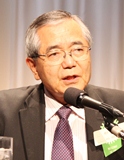D-Block Transition Metal Catalysts Will Save the 21st Century
November 30, 2011
Mr. Ei-ichi Negishi
Herbert C. Brown Distinguished Professor of Chemistry, Purdue University
 ��There is no doubt that the world population will increase steadily through the 21st century, which will aggravate various issues including food, clothing and fuel. Majority of such issues relate to organic compounds that contain one or more carbon atoms. I am convinced organic synthesis will come to play an even greater role to deal with these growing issues.
��There is no doubt that the world population will increase steadily through the 21st century, which will aggravate various issues including food, clothing and fuel. Majority of such issues relate to organic compounds that contain one or more carbon atoms. I am convinced organic synthesis will come to play an even greater role to deal with these growing issues.
��Professor Mendeleev is credited to have created the first version of the ��periodic table of elements,�� whom I regard as the father of modern chemistry. It was sometime during 1860-70 while he lived in St. Petersburg.
��The central part of the periodic table is occupied by 24 d-block transition metals (3 rows by 8 vertical columns), including titanium (Ti), zirconium (Zr), vanadium (V), chromium (Cr), molybdenum (Mo), tungsten (W), manganese (Mn) and iron (Fe). Excepting the radioactive technetium (Tc) that cannot be used for synthesis, how to make good use of the remaining 23 metals will be the key. Stainless steel was developed by mixing iron, chromium and nickel. We cannot live without iron, which constructed the modern society. Gold and silver jewelry or copper and platinum are also precious, not to mention palladium (Pd) which we chose as a catalyst.
��The d-block transition metals had been treated as highly precious materials until several decades ago. Around that time, many young scientists, including myself, came to realize ��d-block transition metals could be extremely useful as catalysts�� and started to conduct research. Our research on palladium started several decades ago, and now we have reached the stage where many people regard palladium as a valid catalyst.
��D-block transition metals allow different usage. Utilizing them as catalysts for organic synthesis will be a key to save the 21st century.
��If we take an example of clothing, only natural fibers of cotton, wool and silk were used to make clothes a century ago. We have made good use of such biochemical or biological products. In the early 20th century, Japan suspended its silk export to the US. As a consequence, Nylon was developed by W. H. Carothers, an American researcher of DuPont, as a synthetic replacement for silk and it was commercially manufactured to meet demand. Nylon is a chemical product, made from petroleum and other compounds that are mixed in a thick liquid containing polymer. Polyester fiber is another chemical product developed to replace wool whose production was decreasing. These chemical products have come to replace, compete and coexist with traditional natural products, proving that organic synthesis can save our future.
��My definition of ��organic synthesis�� includes 3 elements of ��YES��: Yield (high-yield synthesis), Efficiency (high-efficiency synthesis by short steps), and Selectivity (pure and highly-selective synthesis). Let me add 2 elements of Economical and Safety, to come up with an acronym ��Y(ES)²�� which I regard as essential elements of green chemistry.
��Among 112 chemical elements, there are about 70 elements that can be utilized and should be fully utilized for synthesis. Radioactive elements (radon (Rn) etc.), toxic elements (cadmium (Cd), mercury (Hg), potassium (K), lead (Pb), tin (Sn), arsenic (As) and beryllium (Be) etc.) as well as the 5 inert gases cannot be utilized for organic synthesis. Out of the 70 elements, there are about 10 elements (including hydrogen (H), carbon (C), nitrogen (N), oxygen (O) and halogen) that could be called organic compound elements as they formulate most of the organic compounds. The remaining 60 elements are mostly metals, of which there are about 20 main-group metals, including (lithium (Li), sodium (Na), calcium (Ca), potassium (K), zinc (Zn), boron (B), aluminum (Al), silicon (Si), germanium (Ge) etc.). Such elements are relatively inexpensive and easily applicable.
��I was awarded the 2010 Nobel Prize for chemistry for my work on ��cross couplings��. At the age of 25, I pursued my academic career at the University of Pennsylvania in Philadelphia, where I had the privilege to attend lectures by Nobel Laureates. Back then, I was working on simplifying the task of organic synthesis. I came up with ��cross-coupling reaction,�� a LEGO-game like method of hooking up 2 different molecules through chemical reaction utilizing metal catalysts. 23 metals are high-potential catalysts that will open many doors for synthetic chemistry.
��At first our group used copper (Cu) and nickel (Ni) as catalysts, and eventually targeted palladium (Pd). Palladium catalyst can be re-used over a million or even 100 million times. Even if 1 unit of palladium costs 1 million yen, the cost falls to 1 yen each time should it be used 1 million times.
��Let me close my speech by encouraging you to make good use of metals. I have committed myself to the challenging task of recycling CO2 by utilizing the d-block transition metals as catalysts.